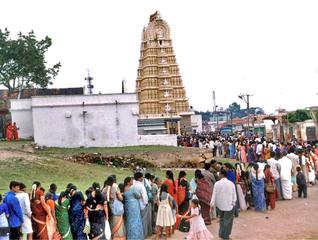Ecological Concerns Cloud Ashada Season at the Famed Chamundi Hills

Mysore, june 24, 2013: The onset of Ashada season in the Hindu almanac also heralds the beginning of the pilgrimage season to the famed Chamundi Hills in Mysore.
The first Friday of the season is on July 12 and the last Friday is on August 2 this year during which lakhs of pilgrims and tourists will have visited the Chamundeshwari temple. Not surprisingly, the district administration has taken measures for the smooth flow of the pilgrims.
The ban on entry of private vehicles to Chamundi Hills on all Fridays of the Ashada — a practice introduced a few years ago to cope with the traffic — is a testimony to this. The emphasis is on providing food and water to the pilgrims as also creating temporary toilets for their benefit which is all welcome.
While the increase in the number of pilgrims and the growing popularity of the shrine augurs well for tourism, it masks the ecological crisis in the making, given the fragility of Chamundi Hills. Far from being a picture of greenery, it is beset with problems of encroachment at the base and degradation at the top and increase in the number of vehicles, unbridled tourism and rampant urbanisation around it has put a question mark over its future.
While public sentiment towards the hill shrine is strong, it has not been harnessed towards its conservation. Conservationist K. Manu of the Mysore Amateur Naturalists (MAN) told The Hindu that Chamundi Hill is an ecological hotspot in an urban area which receives less support for conservation but more for religious activities from the authorities — far more than what the ecosystem can sustain.
The Mysore Master Plan 2031 — which is yet to be notified by the government —has recognised the need for a special status for Chamundi Hills and has called for a 100 metre buffer zone from the edge of the existing forest boundary. It has also called for plantation on the eastern and southern side of the hill and taken exception to the Mysore Urban Development Authority’s (MUDA) plan to develop a residential area on the south-western side and north of Uttanahally Road and has called for its abrogation. But given the stakes involved and the sensitivity of the issue, it is unlikely that the proposal for a buffer zone will get approval.
Environmentalists are also peeved that the concept of development as understood by policy makers hinges on creating infrastructure and is human-centric.
The construction of Dasoha Bhavan atop the hill, the proposal for street lamps along the highway leading to the top, and widening of a stretch of the road and efforts in certain quarters to revive the ropeway project to Chamundi Hills to boost tourism are a few examples of this approach.
While development of Chamundi Hills “on the lines of Tirupati and Vaishno Devi” has been a favourite promise of political leaders, there is little talk of allocating funds for its conservation, according to Mr. Manu.
Environmentalists have pointed out that the city’s micro-climatic conditions are regulated by the hill and it is also an important watershed for 10 lakes enabling ground water recharge apart from being a hotspot for biodiversity. They are wondering whether the authorities will display the same zeal towards conserving Chamundi Hills as for creating facilities for tourists and pilgrims.
Source: The Hindu, DT. June 24, 2013.







